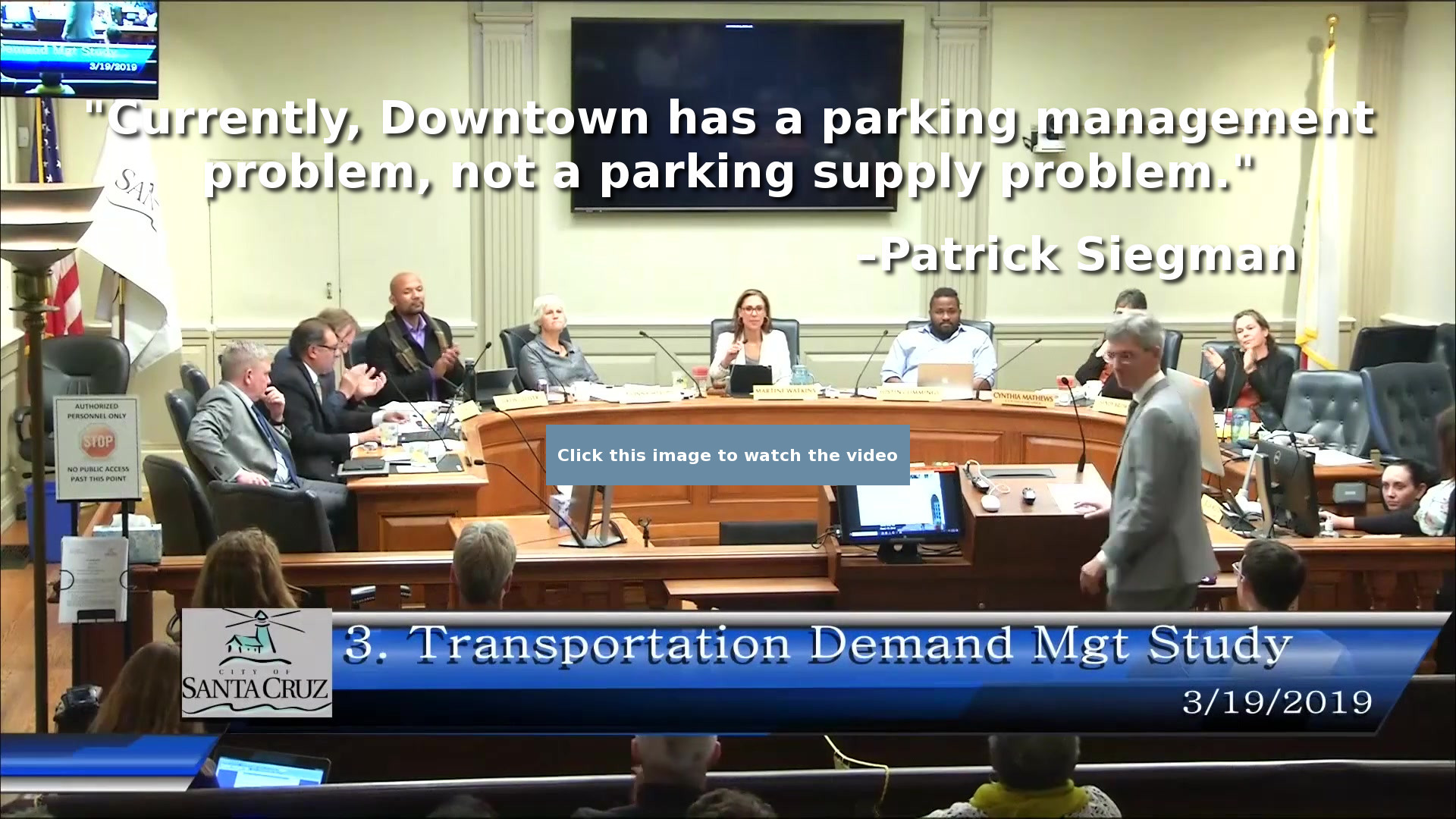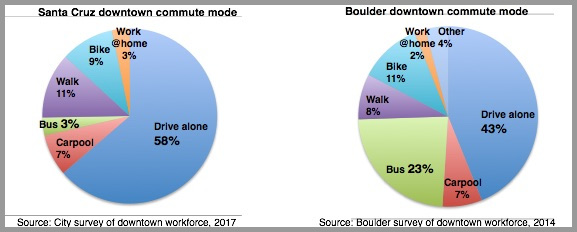Ten Reasons Why Downtown Santa Cruz Doesn't Need a New Garage
(Brought to you by  The Campaign for Sustainable
Transportation)
The Campaign for Sustainable
Transportation)
A relevant and related piece is here.
If you support the position expressed on this page, please consider sending a note to the Santa Cruz City Council members. It's easy: Just click here.
- Parking Demand Downtown Has
Dropped from a Peak in 2008.
The graph above shows the annual count of parked cars in Downtown Santa Cruz on the peak weekday afternoon during the week before Christmas. The maximum number of occupied spaces occurred in 2008, with 84% of the spaces occupied. By 2018, the number of occupied spaces had decreased by 436 vehicles, resulting in only a 71% occupancy.
- Parking Demand Is Predicted to Remain
Stable Through 2025.
In 2016, the City signed a $100,000 contract with Nelson\Nygaard to produce a Downtown Parking Strategic Plan. The study was never completed or submitted to the City Council. Patrick Siegman worked on the study when he was an employee of Nelson\Nygaard.
Siegman, now an independent consultant, presented information from the study to the City Council on March 19, 2019. Siegman predicts that future parking demand will remain flat, in part due to increases in parking rates passed by the City Council in 2018. Siegman's study took into account a decline in parking supply due to development on surface parking lots and increased parking demand due to new development Downtown. He found that the net result would be a surplus of parking well into the next decade.
We encourage you to watch this video of Siegman's presentation to the Santa Cruz City Council by clicking on the image below. It is 55 minutes long, but it is well worth spending the time to watch it, since Siegman describes much of what is on this page. He is an expert, not only on parking issues, but also on the closely related issue of housing availability.

- Parking Demand Around the US is Dropping Due to
Uber, Lyft, etc.
Here are three links:
Decline in parking in San Diego;
At airports;
Decline in parking in San Francisco lowers revenue for parks. - Parking Demand is Projected to Drop once
Automated Vehicles are Prevalent.
Here is an article from Mother Jones.
In his presentation to the City Council in March, UCSC Environmental Studies Professor Adam Millard-Ball advised using price policy to manage its parking resources in this interim period before automated vehicles become prevalent. A detailed recent paper on the price elasticity of parking demand (to what extent will demand decrease if the parking price is increased by, say, 10%?) is available here.
If you would like to have a look at the slides Millard-Ball showed during his presentation, a link to them is here.
- Santa Cruz has High Potential for Mode Shift among
Working Commuters.
According to City statistics, the peak period for parking Downtown is weekday afternoons—not weekends as one might expect in a tourist town. This is due to high numbers of workers parking Downtown. During peak weekday hours, monthly permit holders occupy 60% of spaces in the Locust Garage. Commuters are much more responsive than other travelers to changing behavior in response to parking price increases, according to a meta-analysis of 50 studies of price elasticity in parking.
According to Professor Millard-Ball, parking demand is more responsive to price increases when alternatives are present, such as transit and JUMP bikes. This October the City will roll out a package of incentives for workers Downtown to switch from solo-auto commutes, including free bus passes and JUMP bike credit. The pie charts below compare how people get to work in Downtown Santa Cruz and Downtown Boulder. In spite of Boulder’s cold weather, their drive-alone rate is much lower than in Santa Cruz. If Santa Cruz can match Boulder’s drive alone rate, that would free up significant numbers of parking spaces on weekdays.

- Investment in a New Garage Puts the City at Financial
Risk.
In 2015, parking consultants from three different agencies spoke to a joint meeting of the Planning Commission and Downtown Commission. The consultants were unanimous in advising the City that on financial grounds alone, the City should institute pricing policy and Transportation Demand Management before consideration of a new parking structure.
Janis Rhodes advised the Commissioners to adjust the price of parking to manage demand, raising pricing during peak periods. She said, “When you talk about that $30,000 fee [per parking space], no agency will make enough on user fees to pay for that space. All three of us professionals and all my peers in the industry [have become] very conservative. [We need to maximize] existing inventories before we step out into that arena of financing new resources. It has become extremely difficult and very expensive to [finance new resources].” (This meeting took place a year before City staff proposed a $37 million garage with the capital cost per net new parking space of $78,000.) City staff estimate the annual debt service on the garage to be $2.9 million per year for 30 years. With a drop in parking demand, the City would need to find a way to pay its debt.
If you would like to watch a video of the joint meeting (in 2015) of the Planning Commission and the Downtown Commission with parking consultants, a link to it is here.
- The Garage Project Would Diminish Construction of
Affordable Housing.
State and federal funding is not available for the small number of affordable units that the City proposes to include in the 600 parking space garage-library. If the City spends its limited local dollars on a small project, it will yield far fewer affordable units than those that could be built leveraging state and federal funds. The City can support affordable housing projects Downtown by reducing or waiving parking requirements and providing overnight parking in City garages. Adding another 600 parking spaces when City garages have very few parked cars overnight is a waste of funds that could go to support the construction of affordable housing.
- If there is a Localized Need for Visitor Parking,
the City Could Partner with Property Owners to Provide a
Parking Supply.
As an example, Calvary Church wants to build housing on its parking lot that the City currently leases. The City could partner with Calvary, providing parking on the ground floor, and a subsidy for affordable housing construction above.
- An Oversupply of Parking Encourages Vehicle Miles
Traveled and Diminishes the Public Realm.
Ria Hutabarat Lo from Nelson\Nygaard told the Planning and Downtown Commission, “Parking will be over-consumed if it's given away for free or underpriced.” The cost of monthly parking permits is subsidized by hourly parking meters and a fee charged to businesses Downtown. Cheap parking undermines transit ridership and increases traffic. Large parking structures diminish the quality of the pedestrian experience.
- The Garage Project Misses the Opportunity of
Improving the Farmers Market Lot as a Town Commons.
The proposed garage plans would require moving the Farmers Market to a less pedestrian-friendly location on Front Street that has three times the vehicle traffic of Cedar Street. This proposed move exemplifies what the City’s Downtown Plan cautioned against, “Open spaces within downtown Santa Cruz should have value and meaning; they should be carefully located where people want to be and in locations that take advantage of the unique resources, heritage, and traditions of the community. They should not be contrived or created from ‘leftover’ space.”